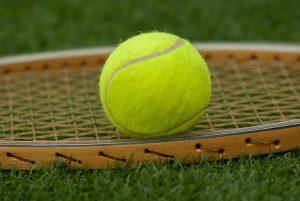We may earn money or products from the companies mentioned in this post.
How Does Serving Work In Tennis: An Introduction

When it comes to the game of tennis, the serve is a fundamental aspect that can make or break a player’s performance A well-executed serve not only starts a point but also puts pressure on the opponent right from the start Let’s dive into an overview of how serving works in tennis and explore its importance and different types
Importance of a good serve
A good serve can set the tone for a match by dictating the pace and direction of play It gives players an opportunity to gain control and put their opponents on the defensive A strong serve can also earn free points through aces or force weak returns, allowing players to take control of rallies right from the beginning
Types of serves
In tennis, there are several types of serves that players can utilize to keep their opponents guessing Here are three common types:
-
Flat serve:
This serve involves hitting the ball with minimal spin, focusing on speed and power It typically travels in a straight line, making it challenging for opponents to anticipate where it will land -
Slice serve:
The slice serve incorporates sidespin, causing the ball to curve away from the server’s dominant hand (for right-handed players, this would be towards their left). This adds variation and makes returning more difficult for opponents -
Kick serve:
Also known as a topspin serve, this type imparts significant topspin on the ball, causing it to bounce higher and kick up towards an opponent’s shoulder or head level The kick serve is effective in creating uncomfortable positions for returners
Basic rules of serving in tennis matches
Understanding the basic rules of serving is crucial for players to navigate through a match effectively Here are a couple of key rules:
-
Order of serving:
The order of serving is determined by a coin toss or other means at the start of a match The winner can choose to serve or receive first After the first game, players alternate their turns to serve -
Changing service courts:
Players switch service courts after every odd-numbered game This ensures that both players have an equal opportunity to adjust to different angles and wind conditions on the court
In conclusion, the serve is an essential aspect of tennis that can significantly impact a player’s performance By mastering different types of serves and understanding the rules surrounding serving in matches, players can gain a strategic advantage over their opponents
The Grip: Finding the Right Grip for Your Serve

When it comes to serving in tennis, the grip you use can make all the difference The continental grip is widely regarded as the most effective grip for serves This grip involves placing your base knuckle of the index finger on the third bevel of the racket handle
On the other hand, Eastern and Western grips are not ideal for serves The Eastern grip, commonly used for groundstrokes, lacks the necessary wrist mobility for a powerful serve The Western grip, popular among topspin players, can cause inconsistencies and reduce control when trying to generate speed on your serve
The Stance: Positioning Yourself for Success

The stance you choose before serving plays a crucial role in your ability to execute an effective serve There are two main stances to consider: platform stance and pinpoint stance
In a platform stance, both feet are parallel to each other, providing a stable base This stance is suitable for beginners or those looking for more stability during their serve In contrast, a pinpoint stance involves positioning your feet with one foot slightly ahead of the other This allows for greater coil and hip rotation, enabling more power behind your serve
The Toss: Setting Up the Perfect Ball Toss

Consistency is key when it comes to tossing the ball for your serve Practice maintaining a consistent toss height and placement to develop better timing and precision Focus on releasing the ball from a controlled motion at a consistent release point above your hitting zone
The Swing and Follow-Through: Executing a Powerful and Accurate Serve

To execute a powerful and accurate serve, pay attention to four essential elements: loading phase, racquet drop, contact point, and follow-through
During the loading phase, bend your knees, rotate your hips, and tilt your shoulders to generate power and coil your body for an explosive serve
The racquet drop is the next crucial step Bring the racket back behind you with a smooth motion, allowing it to drop naturally into position
When you reach the contact point, make sure to strike the ball at its highest peak This will maximize power and control over the direction of your serve
Finally, follow through with a complete motion that lands you inside the court A proper follow-through ensures that you maintain balance and control after hitting the ball
Common Service Faults and How to Fix Them

In the game of tennis, service faults can be a frustrating and costly part of your performance Whether it’s double faults, foot faults, or net violations, these mistakes can lead to lost points and even matches But fear not! With some awareness and practice, you can overcome these common service faults and improve your game
Double Faults: Consequences and Prevention Strategies
Double faults occur when both serves go out of bounds or fail to clear the net Not only do they cost you valuable points, but they also give your opponent an advantage One way to address this issue is by practicing second serves consistently By honing your second serve technique through repetition, you’ll build confidence and reduce the chances of double faults
Maintaining composure during pressure situations is another crucial strategy for preventing double faults When the stakes are high or nerves start to creep in, it’s easy to rush into serving without proper focus Take a moment before each serve to calm your mind, control your breathing, and visualize a successful delivery This mental preparation will help you stay composed under pressure
Foot Faults: Understanding Their Impact on Your Game
Foot faults occur when any part of your foot touches or crosses over the baseline while serving These infractions not only result in losing the point but can also disrupt your rhythm and throw off your timing To eliminate foot faults from your game, start by identifying common mistakes such as improper positioning or lack of awareness about where your feet are landing
Tips for eliminating foot faults include maintaining proper court positioning during serve preparation and making sure that you have enough space behind the baseline for a smooth follow-through Practicing with a coach or partner who can provide feedback on your footwork can also be beneficial in correcting any flaws in your technique
Net Violations When Serving
Net violations during the service occur when you touch the net with any part of your body or racket, or if the ball hits the net and fails to clear it on a serve These mistakes not only result in losing the point but can also lead to frustration and loss of confidence To avoid net violations, it’s important to understand the different types that can occur
Common net violations include touching the net with your body or racket while serving, as well as failing to clear the net on a serve attempt To prevent these errors, focus on maintaining a proper distance from the net during serves and ensuring a clean swing motion that allows for sufficient clearance over the net Practicing precise ball placement and refining your timing will also help reduce the chances of committing net violations
Mastering Advanced Serving Techniques

In the world of tennis, the serve is often considered the most crucial shot in a player’s arsenal It sets the tone for the point and can dictate the outcome of a match But to truly excel at serving, one must go beyond just hitting it over the net Mastering advanced serving techniques involves adapting your serve to different situations and opponents, improving accuracy and consistency through targeted practice, and incorporating deception to keep your opponents guessing
Adapting the serve to different situations and opponents
Variety is key when it comes to your service game By mixing up your serves with different paces, spins, and placements, you can keep your opponents off balance and gain a competitive edge It’s important to assess each situation and opponent individually to determine what type of serve will be most effective
Target practice: improving accuracy and consistency
To improve your serving accuracy and consistency, setting targets on the court during practice sessions can be incredibly beneficial By aiming for specific spots on the service box, you can develop muscle memory that will help you hit those spots consistently during matches This type of focused practice allows you to fine-tune your technique and increase your chances of landing well-placed serves
Incorporating deception into your serve
Deception is a powerful weapon in any tennis player’s arsenal, especially when it comes to serving By disguising toss locations and racquet preparation, you can confuse your opponents and make it harder for them to anticipate where your serve will go Additionally, last-minute adjustments before making contact with the ball can leave opponents guessing about whether you’re going for power or placement
Mastering advanced serving techniques requires dedication, practice, and a willingness to experiment with different strategies By adapting your serve to different situations and opponents, improving accuracy through target practice, and incorporating deception into your service game, you can take your serving skills to a whole new level So step onto the court with confidence and let your serves become weapons that dominate the game
Useful Links

How To Play Tennis | Rules of Sport
Serving
How to Serve a Tennis Ball (with Pictures)
How To Serve In Tennis – 6 Simple SECRETS To A Great Serve
Tennis Tips: Rules of Serving – YouTube
Serve rules and tactics | Fitness
Tennis Serve Technique – 7 Steps To Correct Serve
Summary of Tennis Rules
Do You Alternate Serves In Tennis?
Rules of Platform Tennis
How Does A Tennis Tie-Break Work?
How do serves work in tennis?
How to Breeze Through Your Serve Games in Tennis
Official Rules of Table Tennis
Complete Guide to Serve Strategy for Doubles
Table Tennis rules explained: 11 frequently asked questions
Tennis explained: Learn the game
Why The Jump Serve Is Illegal In Tennis
Beginners Guide to Tennis Terminology
Tie-Break Serving Order. Meaning in tennis. Definition. …






